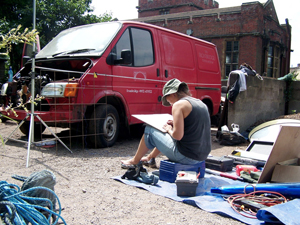___________________________________________________________________________________________________
_
about | exhibitions | artists | venues | workspaces
___________________________________________________________________________________________________
_
In Transit | the excavation of a transit van
In 2006 a small team of archaeologists from Bristol University excavated a Ford Transit van. Archaeologists at the World Heritage Site of Ironbridge Gorge- supposed birthplace of the Industrial Revolution were its former keepers.
Still in Transit
Assembled by 4023 humans and 125 robots from disparate stuff sent from eighteen countries. Only to be disassembled by two or three archaeologists and broadcast to different continents- it was recycled to sprout all-sorts.
Other archaeologists had used it and abused it. Finally, we arrived to forensically – thoughtfully - carefully - wreck it, in slow motion.
In their time, organisms shed their stuff- beetle wing and dog hair, hair-gel, and pencil stub, the Transit was colonised by moss and men*. It was a marked van. Cracked, pecked and polished- rust, patina and epoxy resin brought automatic landscape to mind.
Cupped and ringed, ridged and furrowed the vehicle was all terrain.
‘What’s it all in aid of?’, you might well ask.
'Somebody had to do it', we may well answer.
So, we measured it, planned it, drew it, and photographed it, sampled it, listened to it- and wrote and wrote… about it.
Well remembered then- in a dispersed way.
Sic Transit Gloria
(*women)
-Greg Bailey, May 2008
Project Team
The van project, inspired by Alan Bennett’s story of ‘The Lady in the Van’ was conceived and led by John Schofield-University of Bristol.
Archaeological & mechanical methodologies were designed by Cassie Newland- University of Bristol.
Greg Bailey (University of Bristol) recorded an oral history and made a short ‘film’.
With the kind permission of Atkins Heritage, Anna Nilsson forensically examined the Transit van.
Steve Davis of University College Dublin reported on the vehicle’s insect assemblage.
The finds report was written by Adrian Myers (University of Bristol).
Plan of discrete finds (to view a larger image, click here).
Source materials (to view a larger image, click here).
_
___________________________________________________________________________________________________
Ábhar agus Meon, Sixth World Archaeological Congress, School of Archaeology, University College Dublin, Dublin 4, Ireland
(@) http://www.ucd.ie/wac-6 (@) http://www.amexhibition.com (e) info(at)amexhibition.com
(t) +353 (0)87 654 8301 (f) + 353 (0)1 716 1184
Designed by iArchitectures (2008).









